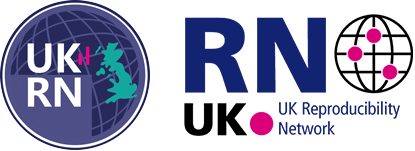Contents
Open Research across Disciplines
How the principles of open research can be applied to your disciplineComputer Science
To suggest improvements or additions to this page, please use this form.
Case Studies
UKRN case study: computer science
University of Bristol case study: Data Hazards: collaborative ethical thinking for data science projects. Video.
University of Manchester case study: WorkflowHub open registry for the life science community to openly share, find and reuse data processing pipelines
University of Sheffield Open Research Case Study: Sina Tabakhi – Developing a FAIR-compliant open-source feature selection tool: UniFeat
Examples of open research practices
Open Methods: The Open Science Grid (OSG) is a large-scale computational infrastructure based in the United States and partly funded by the Department of Energy. Having been applied to highly reputable experiments such as the Large Hadron Collider, the OSG holds an invaluable role in supporting a variety of scientific applications by providing service and support to resource providers and research institutions. This is achieved by allowing contributors to grant access to their computing, storage and software resources which promotes usage of shared data and resources. With aims to expand further globally, the OSG plays a key role in ensuring a collaborative environment for scientists and researchers working on computing issues and solutions development as well as guiding new, less experienced users in the computing community. (https://opensciencegrid.org)
Open Methods: Good computing workflow practices. Summarised in Box 1 of Wilson et al. (2017). For example:
“Software
- Place a brief explanatory comment at the start of every program.
- Decompose programs into functions.
- Be ruthless about eliminating duplication.
- Always search for well-maintained software libraries that do what you need.
- Test libraries before relying on them.
- Give functions and variables meaningful names.
- Make dependencies and requirements explicit.
- Do not comment and uncomment sections of code to control a program’s behaviour.
- Provide a simple example or test data set.
- Submit code to a reputable DOI-issuing repository.”
Open Data and Open Education: Tim Coughlan from The Open University provides his case study of postgraduate computer science in using open data as a material for describing the process of producing assignments, and learner responses to them. He views open data as a powerful material for designing learning activities because of its qualities of ease of access and authenticity. As assignments, students used e-book text files which required them to build an e-reader application. They were then given a set of requirements that progressed from the basic creation of the application, towards challenging them to make use of the data that is available that suits them in complex ways. Feedback from the assignments shows that students responded well to the assignments and reported a high degree of satisfaction.
(http://education.okfn.org/handbooks/open-data-as-open-educational-resources/)
Resources
General Resources
- Fernández, D. M., Graziotin, D., Wagner, S., and Seibold, H. (2019). Open science in software engineering. https://arxiv.org/abs/1904.06499
- Wilson G, Bryan J, Cranston K,Kitzes J, Nederbragt L, Teal TK (2017) Good enough practices in scientific computing. PLoS Comput Biol, 13(6): e1005510. https://doi.org/10.1371/journal.pcbi.1005510
Open Methods
- List of open-source software. http://openscience.org/software/computer-science/
Open Data
- https://researchportal.hw.ac.uk/en/organisations/computer-science/datasets/
- Open dataset and tools. https://cocodataset.org/#home
- Open Evidence bank. https://www.software.ac.uk/open-evidence-bank
- Computer Science resources (standards, databases, data policies) registered in FAIRsharing: https://fairsharing.org/browse/subject?term=Computer%2520Science
Open Outputs
- Electronic Colloquium on Computational Complexity. https://eccc.weizmann.ac.il/eccc/
- Preprint repository. https://arxiv.org/
- Database of open access conference processing, journals and repositories. open-access.network: Open Access in Computer Science
- Journal of Open-Source Software. https://joss.theoj.org/
This page is adapted and extended from: Farran, E. K., Silverstein, P., Ameen, A. A., Misheva, I., & Gilmore, C. (2020, December 15). Open Research: Examples of good practice, and resources across disciplines. https://doi.org/10.31219/osf.io/3r8hb
